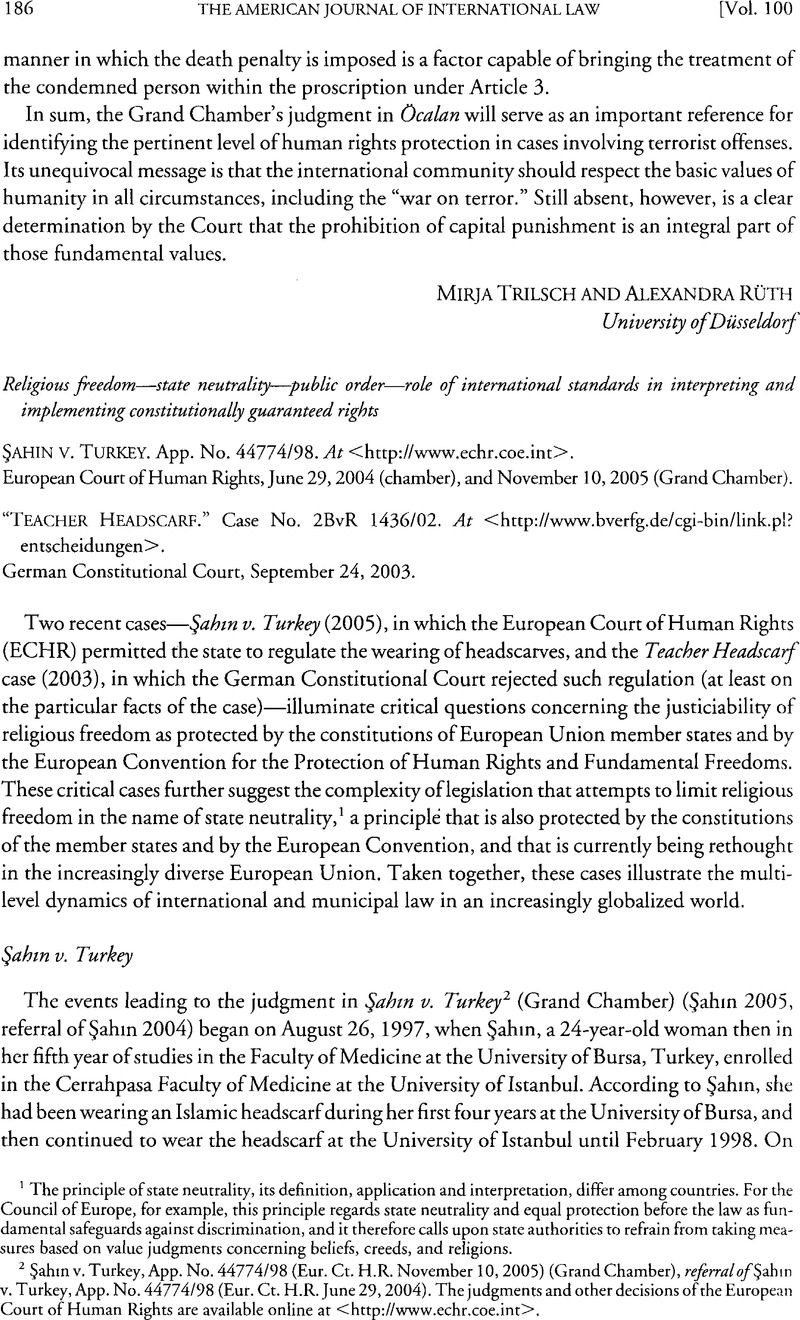Article contents
Şahin v. Turkey. App. No. 44774/98; “Teacher Headscarf.” Case No. 2BvR 1436/02
Published online by Cambridge University Press: 27 February 2017
Abstract

- Type
- International Decisions
- Information
- Copyright
- Copyright © American Society of International Law 2006
References
1 The principle of state neutrality, its definition, application and interpretation, differ among countries. For the Council of Europe, for example, this principle regards state neutrality and equal protection before the law as fundamental safeguards against discrimination, and it therefore calls upon state authorities to refrain from taking measures based on value judgments concerning beliefs, creeds, and religions.
2 Şahin v. Turkey, App. No. 44774/98 (Eur. Ct. H.R. November 10, 2005) (Grand Chamber), referral of Şahin
v. Turkey, App. No. 44774/98 (Eur. Ct. H.R. June 29,2004). The judgments and other decisions of the European Court of Human Rights are available online at <http://www.echr.coe.int>.
3 Nov. 4, 1950, ETS No. 5, 213 UNTS 222. The Convention and its protocols are available at <http://www.echr.coe.int>.
4 This bill became law (No. 2004-28) in March 2004.
5 Case No. 2BvR 1436/02 (Bundesverfassungsgericht [BVerfG; Constitutional Court] Sept. 24, 2003). The Constitutional Court’s own press release announcing the judgment describes the case as Lehrerin mit Kipftuch (Teacher with Headscarf). Press Release No. 71/2003 (Sept. 24, 2003), at <http://www.bverfg.de/cgi-bin/link.pl-?presse>. All translations from the German are by the author.
7 July 4, 2002, BVerwG 2 C 21.01.
8 Court Hears Muslim Teacher’s Case for Head Scarf’(June 6, 2003), at <http://www.germany.info/relaunch/info/publications/week/2003/030606/politics4.html>.
9 Kampf ums Kopftuch [Battle over Headscarf] (Sept. 23, 2003), at <http://www.zdf.de/ZDFde/inhalt/26/0,1872,2068602,00.html>.
10 Winnifred Fallers Sullivan, The Impossibility of Religious Freedom 157 (2005).
11 On the clash of civilizations see, principally, Samuel, P. Huntington The Clash of Civilizations and the Remaking of World Order (1996).Google Scholar
12 Interestingly, it was one year after France’s 2004 ban on “visible” religious symbols for students in all public primary and secondary schools that France saw its worst disturbance to public order since the events of 1968. During this public order crisis of November 2005, rioting youth in disadvantaged neighborhoods throughout France (many of which had significant, if not majority, Muslim populations) set thousands of vehicles on fire and destroyed numerous public buildings, including schools, resulting in the imposition of more than three months of a “state of emergency” (and of restricted civil liberties) throughout France. For an analysis of these events, see Bonelli, Laurent Les raisons d’une colère, Le Monde Diplomatique, Dec. 2005, at 1.Google Scholar
13 See Gerstenberg, Oliver Germany: Freedom of Conscience in Public Schools, 3 Int’l J. Const. L. 94 (2005).Google Scholar
14 2 Decisions of the Bundesverfassungsgericht, pt. 1, at vi (1998).
15 BVerfG, May 16, 1995, 93 BVerfGE 1.
16 Admi ssibility, 2001-V Eur. Ct. H.R.
17 Communication No. 931/2000, UN Doc. CCPR/C/82/D/931/2000 (2005).
18 Dec. 16, 1966, 999 UNTS 331. Article 18(2) provides: “No one shall be subject to coercion which would impair his freedom to have or to adopt a religion or belief of his choice.’’
19 Communication No. 931/2000, para. 6.2.
20 Id., Wedgwood op., paras. 3 -4 (emphasis added).
21 Toobin, Jeffrey Swing Shift: How Anthony Kennedy’s Passion for Foreign Law Could Change the Supreme Court, New Yorker, Sept. 12, 2005, at 42, 42.Google Scholar
- 10
- Cited by




